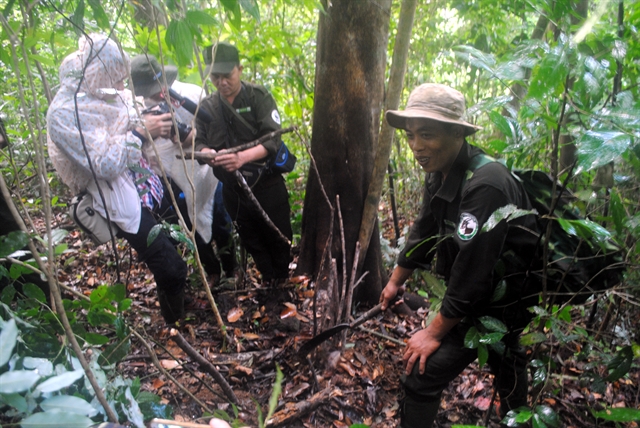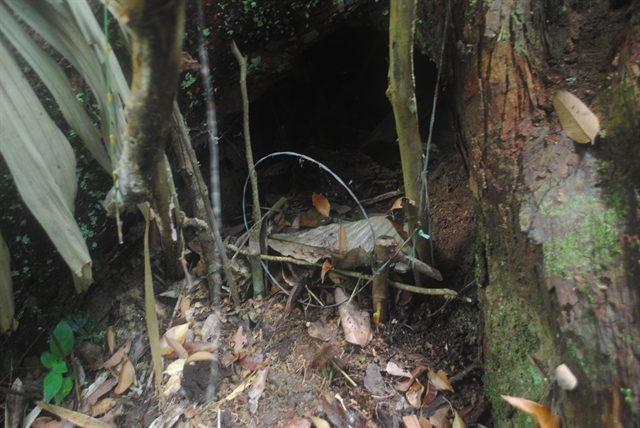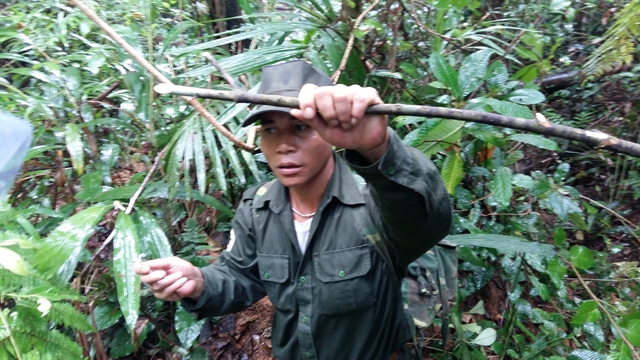 Environment
Environment

 |
| Rangers inspect possible snaring area in the Thừa Thiên Huế Provincial Saola Nature Reserve in mountainous A Lưới district. Labour-intensive removal efforts brought snaring down by almost 40 percent in the reserves in Thừa Thiên Huế and Quảng Nam Provinces. VNS Photo Công Thành |
Công Thành
THỪA THIÊN-HUẾ — Labour-intensive removal efforts have brought snaring incidents down by almost 40 per cent in a region of central Việt Nam, data has shown.
For the past eleven years, ranger patrols have been working across the Thừa Thiên Huế and Quảng Nam Saola Nature Reserves, actively removing snares and traps which have been killing rare and endangered species.
In a report, WWF-Viet Nam said from 2011 to 2021, WWF-Viet Nam and local authorities supported removing close to 120,000 snares from the reserves.
The reserves are home to several threatened species, including large-antlered muntjac (Muntiacus vuquangenis), Trường Sơn muntjac (Muntiacus truongsonenis), Owston’s civet (Chrotogale owstoni), Annamite Striped Rabbit (Nesolagus timminsi), Annamite Crested Argus (Rheinardia ocellata), red and grey shanked douc langurs (Pygathrix spp) and several pheasants (Lophura spp).
 |
| A steel wire snare is found in forest of Thứa Thiên Huế Province. Snare removal is labour-intensive and costly, but rangers need to cover large areas on foot in rugged and inaccessible terrain. — VNS Photo Công Thành |
While snare removal is labour-intensive and costly, it is used more often than other methods because it is straightforward. Since rangers need to cover large areas on foot in rugged and inaccessible terrain, it is used more often than other methods.
To date, few studies have assessed the impact of snare removal on snaring levels over long time periods.
According to WWF-Viet Nam, snaring – a non-selective method of poaching using wire traps – is widespread in tropical forests in Southeast Asia and has decimated wildlife populations, pushing many larger mammals to local or even global extinction.
Further reductions were difficult to achieve despite continued removal efforts. Snare removal is therefore necessary but by itself not sufficient to save the threatened wildlife diversity in tropical forests, scientists conclude in the journal ‘Conservation Letters’
 |
| A ranger in the Saola Nature Reserve in A Lưới district of Thừa Thiên Huế Province demonstrates how to remove a wire snare in forest. VNS Photo Công Thành |
An international team of scientists from the Leibniz Institute for Zoo and Wildlife Research (Leibniz-IZW), WWF-Viet Nam and WWF Asia Pacific, in addition to teams from the Universities of Exeter and Montpellier analysed 11 years of patrol data and concluded that intensive snare removal significantly reduced this threat.
Over the 11-year time frame, the presence of snares in the two reserves declined by 37 per cent. The effect was more pronounced in easily accessible locations, presumably because patrolling was more frequent in these areas.
“What we also found is that, when patrolled, an area is less likely to have many snares afterwards”, says Jürgen Niedballa, a data scientist from the Leibniz-IZW.
“Patrolling acts as a deterrent to future snaring, and therefore is an important measure to counteract the snaring crisis in Southeast Asia.”
On the other hand, snaring levels remained relatively high in more remote parts of the forest.
“The spatial analysis of the patrol data is of great importance for our daily management”, added Lương Việt Hùng, project manager of WWF-Viet Nam.
“The maps showing the distribution of snares within the protected areas help us to target our patrolling activities to those parts of the reserves that need the most attention.”
The scientists also found that the decrease in snaring levels was mainly achieved within the first six years of patrolling. After that, despite continuous efforts, snare presence remained resistant to any further declines.
“Our results show snare removal alone is unlikely to protect wildlife in Southeast Asian protected areas”, says Andrew Tilker, scientist at the Leibniz-IZW and Species Conservation Coordinator at Re:wild.
“This is especially true for rare or snaring-sensitive species, many of which are now on the brink of extinction in Việt Nam.”
 |
| A forest trekking team join a survey in the Elephant Conservation site in Nông Sơn district of Quảng Nam Province. Snare removal efforts have helped reduce snaring crisis in the Quảng Nam Saola Nature Reserve. VNS Photo Công Thành |
The findings show that it is important to view snare removal as part of a wider, multi-faceted conservation response that addresses the underlying drivers, the authors conclude in the paper. “Relying solely on snare removal will not be sufficient to address the threat at scale”, said Nguyễn Văn Trí Tín, Wildlife Practice Lead of WWF-Viet Nam.
“In collaboration with other conservation partners, we are now engaged in larger multi-disciplinary conservation initiatives such as cross-border cooperation in tackling illegal wildlife trade; livelihood improvement, awareness raising and behaviour change programmes to complement snare removal to prevent snares being set in the first place. With these additional efforts, we can address the root cause of the problem and make the forests of the Central Annamite Mountains in Viet Nam safe again for wildlife.”
One of these initiatives is the CarBi II project (Carbon sinks and biodiversity partnership, phase 2), by WWF-Viet Nam and Laos through the German Development Bank (KfW) and part of the International Climate Initiative (IKI).
Although the wildlife of Southeast Asia is facing an unprecedented threat from snaring, there is hope that, when intensive snare removal is combined with more holistic approaches, the threat can be addressed at the scale needed for large-scale wildlife recovery, the authors conclude. Reducing snaring across Southeast Asia’s protected areas will take substantial resources and an as-yet unrealised level of political commitment from the region’s governments – but it is a future that is within reach.
The Bạch Mã National Park in Thừa Thiên Huế Province has been selected as the site for the world’s only breeding centre for the saola, also known as the Asian unicorn, the extremely elusive forest-dwelling bovine only found in the forests of Việt Nam and Laos.
The saola is a critically endangered creature that was the eighth new large mammal species to be discovered in the 20th century. VNS